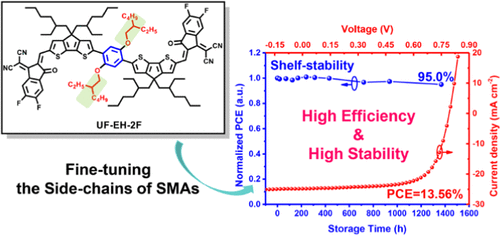当前位置:
X-MOL 学术
›
Chem. Mater.
›
论文详情
Our official English website, www.x-mol.net, welcomes your feedback! (Note: you will need to create a separate account there.)
Achieving an Efficient and Stable Morphology in Organic Solar Cells Via Fine-Tuning the Side Chains of Small-Molecule Acceptors
Chemistry of Materials ( IF 8.6 ) Pub Date : 2020-03-12 , DOI: 10.1021/acs.chemmater.0c00097 Meijia Chang 1, 2 , Lingxian Meng 1 , Yunchuang Wang 1 , Xin Ke 1 , Yuan-Qiu-Qiang Yi 1 , Nan Zheng 3 , Wenyu Zheng 4 , Zengqi Xie 3 , Mingtao Zhang 1 , Yuanping Yi 4 , Hongtao Zhang 1 , Xiangjian Wan 1 , Chenxi Li 1 , Yongsheng Chen 1
Chemistry of Materials ( IF 8.6 ) Pub Date : 2020-03-12 , DOI: 10.1021/acs.chemmater.0c00097 Meijia Chang 1, 2 , Lingxian Meng 1 , Yunchuang Wang 1 , Xin Ke 1 , Yuan-Qiu-Qiang Yi 1 , Nan Zheng 3 , Wenyu Zheng 4 , Zengqi Xie 3 , Mingtao Zhang 1 , Yuanping Yi 4 , Hongtao Zhang 1 , Xiangjian Wan 1 , Chenxi Li 1 , Yongsheng Chen 1
Affiliation

|
Both the efficiency and stability of low-cost organic solar cells are central components for meeting the requirements of commercialization for organic photovoltaics (OPV). Furthermore, the relationship between the chemical structure of an active material and morphology and its effects on efficiency and stability is still largely undetermined. Additionally, both the kinetic and thermodynamic morphology states of an active layer can have a huge impact on efficiency and stability, even when the chemical structures of materials applied in the active layer are especially the same or similar. Here, using two series of acceptor–donor–acceptor (A–D–A)-type small-molecule acceptors (SMAs) with similar backbone structures, we demonstrate the relevance of fine-tuned chemical structures with their solution and solid-state properties, further leading to significantly different behavior in terms of both device efficiency and stability. This is also partially due to the different morphology states caused by such fine chemical structure tuning. Our results indicate that a delicate balance of molecular aggregation and ordered stacking morphology is required to achieve and lead to high efficiency and stability. Thus, among the two series of molecules, UF-EH-2F, with both optimal length and steric hindrance of side chains, achieves the preponderant morphology in its corresponding device, where its morphologies “efficient state” and “stable state” are almost overlapped, and thus lead to both the highest efficiency (power conversion efficiency, PCE = 13.56%) and the best stability. Our results indicate that it is highly possible to achieve the morphology state required for both high efficiency and stability simultaneously by fine-tuning the chemical structure of active materials for organic solar cells.
中文翻译:

通过微调小分子受体的侧链实现有机太阳能电池中高效稳定的形貌
低成本有机太阳能电池的效率和稳定性都是满足有机光伏(OPV)商业化要求的核心组件。此外,活性材料的化学结构和形态之间的关系及其对效率和稳定性的影响仍未确定。另外,即使当施加在活性层中的材料的化学结构特别相同或相似时,活性层的动力学和热力学形态状态也会对效率和稳定性产生巨大影响。在这里,使用具有相似主链结构的两个受体-施主-受体(A–D–A)型小分子受体(SMA)系列,我们证明了微调化学结构与其溶液和固态性质的相关性,进一步导致在设备效率和稳定性方面的显着不同。这也部分是由于这种精细的化学结构调节导致的不同形态状态。我们的结果表明,要实现并导致高效和稳定,就需要在分子聚集和有序堆积形态之间达到微妙的平衡。因此,在这两个分子系列中,具有最佳长度和侧链位阻的UF-EH-2F在其相应的装置中实现了优越的形态,其形态“有效态”和“稳定态”几乎重叠,从而带来最高的效率(功率转换效率,PCE = 13.56%)和最佳的稳定性。
更新日期:2020-03-12
中文翻译:

通过微调小分子受体的侧链实现有机太阳能电池中高效稳定的形貌
低成本有机太阳能电池的效率和稳定性都是满足有机光伏(OPV)商业化要求的核心组件。此外,活性材料的化学结构和形态之间的关系及其对效率和稳定性的影响仍未确定。另外,即使当施加在活性层中的材料的化学结构特别相同或相似时,活性层的动力学和热力学形态状态也会对效率和稳定性产生巨大影响。在这里,使用具有相似主链结构的两个受体-施主-受体(A–D–A)型小分子受体(SMA)系列,我们证明了微调化学结构与其溶液和固态性质的相关性,进一步导致在设备效率和稳定性方面的显着不同。这也部分是由于这种精细的化学结构调节导致的不同形态状态。我们的结果表明,要实现并导致高效和稳定,就需要在分子聚集和有序堆积形态之间达到微妙的平衡。因此,在这两个分子系列中,具有最佳长度和侧链位阻的UF-EH-2F在其相应的装置中实现了优越的形态,其形态“有效态”和“稳定态”几乎重叠,从而带来最高的效率(功率转换效率,PCE = 13.56%)和最佳的稳定性。



























 京公网安备 11010802027423号
京公网安备 11010802027423号